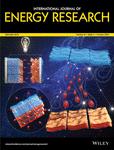Effect of a direct current electric field on CO2 bubble evolution in a direct methanol fuel cell
Funding information: Fundamental Research Funds for the Central Universities, Grant/Award Number: 18CX02129A; Key Research and Development Program of Shandong, China, Grant/Award Number: 2018GHY115018; Natural Science Foundation of Shandong Province, Grant/Award Number: ZR2020ME174; National Natural Science Foundation of China, Grant/Award Number: 51506225
Summary
In direct methanol fuel cell (DMFC) anode microchannels, the retention of CO2 leads to an anodic polarization reaction. Controlling CO2 discharge in the anode channel by a direct current (DC) electric field is beneficial for reducing the anodic polarization reaction. In this work, numerical simulation was the main scientific research method, and the leaky dielectric model was used to characterize the effect of the electric field force. An unsteady theoretical model was established by bidirectionally coupling the electric field and multiphase flow field, which, for this research, indicates the formation of CO2 Taylor bubble flow in a methanol aqueous solution within a DMFC anodic microchannel. Based on this theoretical model, the regulation mechanism of the DC electric field on the dynamic behavior of Taylor bubble formation in DMFC anode microchannels was studied. In the anode channel, the electric field increases the likelihood that the neck of the CO2 bubble will fracture during Taylor bubble formation. The higher electric field intensity increases the formation rate of CO2 bubbles and reduces their size. In addition, the electric field reduces the number of satellite bubbles in the anode channel and promotes the mass transfer rate of the methanol aqueous solution. The results show that the movement characteristics of CO2 can be effectively controlled by applying a DC electric field in the DMFC anode microchannel, which provides a new way to reduce the anodic polarization effect of the DMFC.




